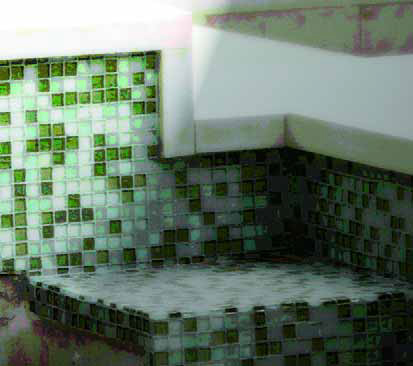construction
When I was a kid, the conventional part of my education in environmental design came in helping my father, Jay Stang, plant parkways and blocks of Pinus Pinea across the city. The unconventional part - the part that apparently took firmer root as I grew up - had me admiring the plate he'd made from hardwood with the dozen split avocado pits he'd carved and mounted on the surface; it also had me listening to my mother, Judy Campbell, tell me that the earth was here first, that the garden already exists and that pathways, watershapes and structures are best built around what we find there. Those unconventional lessons - one about creativity and vision, the other about respect for nature and a method for approaching it - have stayed with me through the years and have given me access to a number of incredible projects. As is the case with most intriguing and fascinating designs, the one seen here flowed from a client with whom I developed a close creative connection that resulted in a free exchange of ideas¬ - a synchronized spontaneity that became a pattern for the entire design process. She always had strong thoughts about what she wanted, but she allowed me to interpret and express her ideas based on our conversations and the nature of the site. As designers, it's not unusual for us to be called on to use our skills and figure out what a client such as this one really wants and then suggest ideas we think will work. I call this process "environmental psychiatry" because, while so many clients have a sense of what they want and a laundry list of general ideas, few have a
When I was a kid, the conventional part of my education in environmental design came in helping my father, Jay Stang, plant parkways and blocks of Pinus Pinea across the city. The unconventional part - the part that apparently took firmer root as I grew up - had me admiring the plate he'd made from hardwood with the dozen split avocado pits he'd carved and mounted on the surface; it also had me listening to my mother, Judy Campbell, tell me that the earth was here first, that the garden already exists and that pathways, watershapes and structures are best built around what we find there. Those unconventional lessons - one about creativity and vision, the other about respect for nature and a method for approaching it - have stayed with me through the years and have given me access to a number of incredible projects. As is the case with most intriguing and fascinating designs, the one seen here flowed from a client with whom I developed a close creative connection that resulted in a free exchange of ideas¬ - a synchronized spontaneity that became a pattern for the entire design process. She always had strong thoughts about what she wanted, but she allowed me to interpret and express her ideas based on our conversations and the nature of the site. As designers, it's not unusual for us to be called on to use our skills and figure out what a client such as this one really wants and then suggest ideas we think will work. I call this process "environmental psychiatry" because, while so many clients have a sense of what they want and a laundry list of general ideas, few have a
As custom watershapers, we all know that each combination of client and project presents a unique profile with respect to scope, design goals and the overall mission. In the project seen here, however, that common formulation was elevated by virtue of the fact that we were working with an accomplished architect on what was to be his own home. He came to the table with strong, distinct ideas about style and project direction, but he was also willing to collaborate with us when it came to the details and practicalities of developing a watershape composition that suited both his needs and a spectacular setting. The property - a gently sloping two-acre lot - is located in an exclusive neighborhood in San Marino, Calif., and our work there took place in concert with construction of a gorgeous new home in a classic Mediterranean style. My company, Arcadia Pools & Spas of Arcadia, Calif., had worked with the architect before on a fountain for a commercial property, so we
As custom watershapers, we all know that each combination of client and project presents a unique profile with respect to scope, design goals and the overall mission. In the project seen here, however, that common formulation was elevated by virtue of the fact that we were working with an accomplished architect on what was to be his own home. He came to the table with strong, distinct ideas about style and project direction, but he was also willing to collaborate with us when it came to the details and practicalities of developing a watershape composition that suited both his needs and a spectacular setting. The property - a gently sloping two-acre lot - is located in an exclusive neighborhood in San Marino, Calif., and our work there took place in concert with construction of a gorgeous new home in a classic Mediterranean style. My company, Arcadia Pools & Spas of Arcadia, Calif., had worked with the architect before on a fountain for a commercial property, so we
If you've been involved in major construction projects - initial work or renovations - chances are good that you've come across the need for retaining walls. In many cases, even the simple leveling of a site will require some type of retaining structure to hold back the soil - whether you're cutting fill out and need to support the slope that remains or filling an area and need to keep the new material from washing away. No matter what site we're talking about, retaining walls have one purpose: to hold something back. Whether you need to terrace a sloped yard, hold up a parking lot or
Through the years in these pages and elsewhere, I've been a persistent critic of the shortcomings of the watershaping trades in general - and especially of the pool and spa industry in which I've operated for more than 25 years. Sometimes I've been harsher than others, but my intent has invariably been to define the difference between quality work that elevates the trade and the junk that's held back our industry's reputation. I've never named names, but I've been particularly hard on practitioners who seem eternally stuck in old ways of thinking and working: Their work seldom lines up with the best efforts of which the industry is capable. Just recently, I had a long talk with WaterShapes' editor in which we discussed the development of a new approach to
Through the years in these pages and elsewhere, I've been a persistent critic of the shortcomings of the watershaping trades in general - and especially of the pool and spa industry in which I've operated for more than 25 years. Sometimes I've been harsher than others, but my intent has invariably been to define the difference between quality work that elevates the trade and the junk that's held back our industry's reputation. I've never named names, but I've been particularly hard on practitioners who seem eternally stuck in old ways of thinking and working: Their work seldom lines up with the best efforts of which the industry is capable. Just recently, I had a long talk with WaterShapes' editor in which we discussed the development of a new approach to
All projects come to an end, of course, but there are times when the inevitable takes its own, sweet time. The project featured here, for example, took more than six years from the time I first met the clients until we wrapped things up. Unlike some projects that take a long time because of ongoing problems, change orders and difficult challenges, this one was very much a labor of love from start to finish. Sure, there were some tough spots, but for the most part, this was one of those jobs that we watershapers and landscape professionals can only hope will come along from time to time - projects we don't mind extending through a period of years. This one had everything going for it, starting with great clients who had the resources to do something special as well as playful, fun-loving personalities that made the process exciting and rewarding. Then there was the property: an acre of ocean-view hillside in Brentwood, Calif., with mature trees and a big, Cape Cod-style house that was going through extensive remodeling during the time we were involved with the landscape. The clients wanted something that was elegant but playful, with formal lines and structures but a light overall touch. They insisted on beautiful materials, were heavily involved in every decision and, ultimately, had our firm, New Leaf Landscape of Agoura Hills, Calif., work with
Creating watershapes and landscapes that are natural in appearance is always a challenge, says Ken Alperstein of Pinnacle Design, a firm that specializes in high-end projects related to top-flight golf courses. For this project in Shady Canyon, however, the ante was upped considerably by the site's location in an environmentally sensitive coastal canyon in southern California - a design challenge intensified by regulatory scrutiny every step of the way. It was a job that forced everyone involved to be on exactly the same page at all times. The landscapes and watershapes at the Shady Canyon Golf Club in Irvine, Calif., were developed by the Irvine Company as the heart of an upscale residential community. The wilderness area set aside for the course and its immediate surroundings had a subtle, bucolic charm all its own - a character the design team needed to
Many of the projects I tackle are largely about beauty and elegance and striking just the right balances between my watershaping and the setting, the architecture of the home and the character of my clients. In the case of the project depicted here, however, a couple of other considerations jumped into the mix - including impulses for fun and excitement as well as an overriding need to raise the visual energy level to align with the clients' personalities and a glorious setting. The result is an exquisitely adorned watershape that stands as one of the purest expressions of whimsy and unbridled joy I've ever produced. Truly, it all flowed from the clients and the setting. The clients are quite educated, well-traveled and sophisticated and had both the resources and the desire to do something special. Moreover, they're about as nice a couple as you could ever hope to meet and had refined tastes to match. As for the setting, we're talking beauty in the extreme: The home is a modern masterpiece perched atop a bluff in Malibu, Calif., with 180-degree ocean views and spectacular distant vistas. The only clinker on the property was the existing pool and the surrounding decks - an aggressively plain, kidney-shaped drag surrounded by equally boring decks. It was time for



















